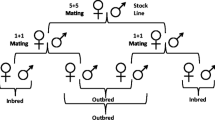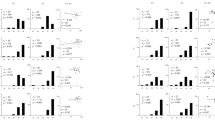Abstract
The contribution of different chromosomes to variation in the gregarious oviposition behavior of Drosophila melanogaster females was elucidate by a chromosome substitution analysis. Lines of D. melanogaster previously selected for more than 190 generations for high or low levels of gregarious oviposition were crossed to a tester strain having genetically marked inversion-containing chromosomes. Genes influencing gregarious oviposition behavior are distributed over chromosome II and III. Interactions among the chromosomes were negligible as measured in this experiment. The differences in the gregarious oviposition performance of these two selected lines is due mainly to the accumulation of factors for high gregarious oviposition on chromosomes II and factors for low gregarious oviposition on chromosome III.
Similar content being viewed by others
References
Atkinson, W. D. (1983). Gregarious oviposition inDrosophila melanogaster is explained by surface texture.Austr. J. Zool. 31:925–929.
Atkinson, W. D., and Shorrocks, B. (1984). Aggregation of larval Diptera over discrete and ephemeral breeding sites: The implications for the coexistence.Am. Nat. 124:336–351.
Brncic, D. (1987). Coexistencia de differentes especies deDrosophila en frutas fermentadas naturalmente.Med. Ambiente 8:3–9.
Brncic, D., and Da Valente, V. L. (1978). Dinamica das comunidades deDrosophila que se establecem em frutos silvestres no Rio Grande do Sul.Ciê. Cult. Brasil 30:1104–1111.
Budnik, M. (1980). Alteration of the preadult viability induced by larval metabolic wastes in different species ofDrosophila.Ciê. Cult. Brasil 34:1391–1394.
Burdick, A. B. (1954). New medium of reproductive quality stable at room temperature.Dros. Info. Serv. 28:170.
Caligari, P. D. S., and Mather, K. (1975). Genotype-environment interaction. III. Interactions inDrosophila melanogaster.Proc. R. Soc. Lond. B,191:387–411.
Chess, K., and Ringo, J. (1985). Oviposition site selection byDrosophila melanogaster andDrosophila simulans.Evolution 39:869–877.
de Jong, J. (1979). The influence of the distribution of juveniles over patches of food on the dynamics of a population.Neth. J. Zool. 29:33–51.
de Jong, J. (1982). The influence of dispersal pattern on the evolution of fecundity.Neth. J. Zool. 32:1–30.
del Solar, E., and Ruiz, G. (1979). Behavior changes inDrosophila melanogaster in the choice of colored substrates for oviposition.Boll. Zool. 46:17–22.
del Solar, E., Ruiz, G., and Köhler, N. (1977). Conducta gregaria y microdistribución geográfica.Med. Ambiente 3:15–25.
del Solar, E., Ruiz, G., and Köhler, N. (1985). Cambios anuales de agregación en la población preadulta deScaptomyza multispinosa (Diptera, Drosophilidae) en cultivos deBrassica napus.Revist. Ch. Hist. Nat. 58:31–37.
Gelfand, D. L., and McDonald, J. F. (1980). Relationships between ADH activity and behavioural response to environmental alcohol inDrosophila.Behav. Genet. 10:237–244.
Mather, K., and Harrison, B. J. (1949). The manifold effect of selection.Heredity 3:1–52, 131–162.
McGuire, T. R. (1992). A biometrical genetic approach to chromosome analysis inDrosophila: Detection of epistatic interactions in geotaxis.Behav. Genet. 22:453–467.
Muller, L. D. (1985). The evolutionary ecology ofDrosophila.Evol. Biol. 19:37–98.
Nunney, L. (1990). Drosophila on oranges—Colonization, competition, and coexistence.Ecology 71:135–136.
Poole, R. W. (1974).Introduction to Mathematical Ecology, John Wiley and Sons, New York.
Rosewell, J., Shorrocks, B., and Edwards, K. (1990). Competition on a divided and ephemeral resource: Testing the assumption. I. Aggregation.J. Anim. Ecol. 59:977–1001.
Ruiz, G. (1992). Aggregation rates in laboratory strains ofDrosophila melanogaster. Dros. Info. Serv. (in press).
Ruiz, G., and del Solar, E. (1986). Effect of selection on oviposition site preference inDrosophila melanogaster.Austr. J. Biol. Sci. 39:155–160.
Ruiz, G., and del Solar, E. (1991). Genetic influences on gregarious oviposition inDrosophila melanogaster.Evol. Biol. 5:37–44.
Ruiz, G., and del Solar, E. (1993). A diallel analysis of gregarious oviposition inDrosophila melanogaster.Heredity 70:281–284.
Sameoto, D. D. and Muller, R. S. (1966). Factors controlling the productivity inDrosophila melanogaster andDrosophila simulans.Ecology 47:695–704.
Seiger, W. B. and Kamus, H. (1987). A multi-factorial behavioral study of coexisting Drosophilid species in nature.Evolution 41:209–217.
Shorrocks, B., and Rosewell, J. (1987). Aggregation does prevent competitive exclusion: A response to Green.Am. Nat. 131:765–771.
Shorrocks, B., Rosewell, J., and Edwards, K. (1990). Competition on a divided and ephemeral resource: Testing the assumptions. II. Association.J. Anim. Ecol. 59:1003–1017.
Author information
Authors and Affiliations
Rights and permissions
About this article
Cite this article
Ruiz-Dubreuil, D.G., Köhler, N. Chromosomal analysis of gregarious oviposition byDrosophila melanogaster . Behav Genet 24, 187–190 (1994). https://doi.org/10.1007/BF01067823
Received:
Accepted:
Issue Date:
DOI: https://doi.org/10.1007/BF01067823




